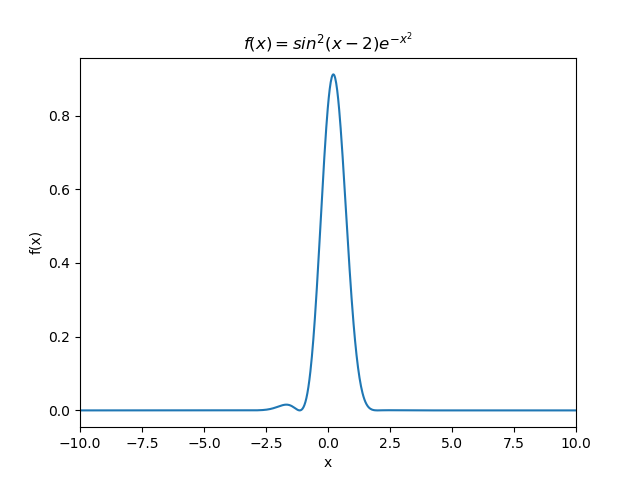Scipy 练习题
Exercise 10.1: Least squares
Generate matrix with . Also generate some vector .
Now find .
Print the norm of the residual.
import numpy as np
from scipy.optimize import leastsq
from scipy.linalg import norm
def error(x, A, b):
'''返回误差'''
x.reshape((10, 1))
result = (A @ x - b).flatten()
return result
A = np.random.random((20, 10))
b = np.random.random((20, 1))
x = np.ones((1, 10))
x = leastsq(error, x, args=(A,b))[0].reshape((10, 1))
print('x = ')
print(x, end='\n\n')
b_ = A @ x
print('The norm of residual: ', end='')
print(norm(b - b_))Output:
x =
[[0.11075377]
[0.11326088]
[0.09987185]
[0.12536225]
[0.11074673]
[0.06318726]
[0.23196592]
[0.06064075]
[0.04162506]
[0.05964665]]
The norm of residual: 1.2490323998004111Exercise 10.2: Optimization
Find the maximum of the function
import numpy as np
import matplotlib.pyplot as plt
import scipy.optimize as opt
import math
func = lambda x : pow(np.sin(x - 2), 2) * np.exp(-1 * (x * x))
negaf = lambda x : -1 * pow(np.sin(x - 2), 2) * np.exp(-1 * (x * x))
res = opt.minimize_scalar(negaf)
print('The maximum is ', end='')
print(-1 * res['fun'], end='.')
x = np.linspace(-10, 10, 1000)
plt.title('$f(x)=sin^2(x-2)e^{-x^2}$')
plt.xlabel('x')
plt.ylabel('f(x)')
plt.xlim(-10, 10)
plt.plot(x, func(x))
plt.show()Output:
The maximum is 0.9116854118471548.
Exercise 10.3: Pairwise distances
Let be a matrix with rows and columns. How can you compute the pairwise distances between every two rows?
As an example application, consider cities, and we are given their coordinates in two columns. Now we want a nice table that tells us for each two cities, how far they are apart.
Again, make sure you make use of Scipy’s functionality instead of writing your own routine.
import numpy as np
from scipy.spatial.distance import pdist
from scipy.spatial.distance import squareform
X = np.random.random((5, 6))
print('Matrix X:')
print(X, end='\n\n')
print('The pairwise distance is shown as a matrix below.')
print('The ith row and jth column element represents the')
print('distance from the ith row and the jth row in matrix X.')
print(squareform(pdist(X)))Output:
Matrix X:
[[0.00149391 0.43881434 0.7238691 0.89246183 0.83287866 0.30924132]
[0.08737163 0.36771012 0.04160294 0.48787342 0.70568696 0.08410919]
[0.49087853 0.12922004 0.69709952 0.56344638 0.67665853 0.23902811]
[0.50285364 0.42753739 0.2185012 0.96359673 0.9051469 0.44587572]
[0.48980019 0.69261204 0.10100373 0.24449646 0.84719487 0.71502118]]
The pairwise distance is shown as a matrix below.
The ith row and jth column element represents the
distance from the ith row and the jth row in matrix X.
[[0. 0.84170772 0.68822114 0.73200908 1.12939759]
[0.84170772 0. 0.82457559 0.77747641 0.86506949]
[0.68822114 0.82457559 0. 0.75716985 1.01494975]
[0.73200908 0.77747641 0.75716985 0. 0.82288731]
[1.12939759 0.86506949 1.01494975 0.82288731 0. ]]